The Q&A: Tom Cocotos
Q: Originally from Leonia, NJ what are some of your favorite things about living and working in New York City?
A: The great city’s sensory overload is always exciting and energizing—it commands one to work hard. But the underrated or less-trademarked treasures with their quality unsurpassed are what sing our town: Dave’s Brisket House in Bed-Stuy, the New York Public Library’s picture collection, Pizza Supreme across from Penn Station and the Writer’s Foundry MFA program at St. Joseph’s College. New York also houses an eclectic and frequently eccentric combination of humanity; I recently played a pick-up volleyball game alongside a bird paleontologist, a musical director of the symphony, and a taxi driver—imagine those perspectives and teamwork all on a single court! Some of the things I still miss: the restaurant Florent, the unadorned, dilapidated, derelict High Line, Julian’s billiards on fourteenth, the St. Mark’s Cinema and the Empire Roller Skating Center in Crown Heights.
Q: Do you keep a sketchbook? What is the balance between the art you create on paper versus in the computer?
A: I find a sketchbook is essential to keep the gears oiled. A pocket sketchbook makes it possible to vary scale, going from 4 x 6 inches, often drawn on the street or in transit and then translating that to ever larger scales, with some works in the studio reaching 12 x 8 feet. To work while traveling about in our mass transit is one of New York’s great luxuries; our amazing subway is among the best transit studios on earth. The system persuades an artist to always keep paper, pencil, glue stick & magazine at the ready.
I keep many small sketchbooks, each devoted to a very specific subject: there are bee sketchbooks, books of portraits—for a while I was doing hundreds of studies of the wonderful NYC poet Marie Ponsot and Warhol Superstar Ultra Violet— and then a book full of machines focusing mainly on back-hoes. Like many artists I’m probably obsessive, but steady practice requires some kind of excess. There are also larger books that house drawings, ideas, poems and technical information about materials. My work nowadays involves many mediums but somehow I can’t shake my affinity for the tactile quality of paper—its tear, scrape and gouge.
Q: What do you like best about your workspace?
A: A set of moveable walls & of course music—the great stimulator! In my workspace a pair of salvaged stereo speakers from a boombox hang and would be at the top of any workspace list. I bought the parts years ago for my first studio on West 12th Street, and their sound has followed me through to about 20 different locations. The system is combined with a tuner and woofer speaker both found in the trash. It sounds great and will hook up to most any electronic device with a headphone jack.
Q: Do you think it needs improvement, if so, what would you change?
A: Many artists I have spoken to say their studios can use improvement so that makes me think it is a perpetual quest and that the perfect workspace may be a fantasy. It seems to me that it’s important to try and get comfortable working wherever you are. But if pressed, because of the music, I’d opt for really good soundproofing!
Q: How do you organize an assignment before you start drawing? Do you make lists and thumbnails?
A: Different people classify fine art in different ways but for my practice the fine art develops its own rhythm and complexion over time and through repetition as a series. And while commissioned or illustrative work often depends on a series as well, it is essential for me to read over the material many times or study the ideas of others as soon as I get an assignment, so I have as much time as possible for that information to percolate in my head. Eventually when the time feels right I’ll start brainstorming through sketches.
Q: How do you know when the art is finished?
A: Whenever that which is now being added or changed begins to make the piece worse.

Q: What was the strangest or most unusual assignment you’ve taken?
A: Recently Citibank commissioned a set of murals—designed to reflect the iconic imagery of NYC, LA and Miami. The catch was all the murals had to be built out of sticky notes, and within one week I traveled to each of the three cities to install the sticky notes live at branch banks. While I worked live, the branch was open and customers began to write messages for the future on the sticky notes. It was part installation, part performance art, part technical wizardry, but the challenge was lots of fun!
Q: What was your favorite book as a child?
A: Babar; for years I wanted to be an elephant, and I still sometimes do.
Q: What is the best book you’ve recently read?
A:
“Blind” by Jose Saramago. I found it in the seat pocket of a plane and could not put it down. I also was thunderstruck by “Gods Without Men,” by Hari Kunzru; and the
poet L.B. Thompson has an amazing new work where poems are formed around the suits of playing cards; and a close friend in publishing just showed me an amazing new manuscript by a young author named
Jason Burstein—about to be published; it’s called “Hubie, the Hero.” The book made me laugh out loud.
Q: If you had to choose one medium to work in for an entire year, eliminating all others, what medium would you choose?
A: Most definitely collage. I’ve been tearing and reconstructing paper since before I could talk. When I’ve hit hardships with a particular medium, I find the addition of collage serves almost like a geographical map informing me on where to turn.
Q: If you could time travel to any era, any place, where would you go?
A: Seventies New York City—a bankrupt manufacturing center filled with acres of beauty and grit, the detritus of urban decay, it was not a comfortable place then, and it drew a certain kind of person: one not needing to be comfortable all the time. There was soul and disco and while I know this is largely a nostalgic desire, I stand by it as a great time for many artists.
Q: What are some of your favorite places/books/blogs/websites for inspiration?
A: Music—ever new and changing, self-constructed studio soundtracks, juxtaposing odd mates—Maria Callas & Grace Jones, Cal Tjader & the Chromatics, & Elvis Presley, Bjork, Shirley Horn, Brian Eno, Flying Lotus, Sonny and Cher, Panda Bear, D’Angelo, Carlos Gardel, The Bird and the Bee, Prince, Fantastic Plastic Machine, The Clash, Fela Kuti, Jobim… it’s hard for me to stop just yet! Also much inspiration comes through collage materials found on the street… electronic debris, candy foils, wine bottle wires and wrappings, and often billboard posters peeling off walls in great big paper hunks.

Q: What was the painting or drawing or flm that most affected your approach to art?
A: There are many of all these swirling around in my head, and dozens come to mind at the moment; the question of sources is always interesting but it’s one of the most difficult questions to answer. If an artist names someone iconic like say Van Gogh it can sound grandiose, or like trying to trade on that great painter’s genius, and if one mentions someone obscure, for example there’s a Welsh scrimshaw artist that I often watch named Clyde Herbie, who goes out of his way to remain anonymous, though collectors know him, and that too begins to sound coy, remote or too exclusive.
There are many films as well, but for some reason two very different movies pop into my head now: one I do not consider a beautiful movie, but “Pump Up the Volume” still impresses me with it’s un-nuanced homage to teenage rebellion and I first saw it at a time when I was turning my back on my training as an engineer, and lusting after something more fulfilling. I related with its characters; it spurred me on. And a movie that I do consider beautiful, “Blow Up,” visually stuck in my head.
Q: What advice would you give a young artist about applying to an art school or college?
A: Once there, experiment and don’t pass up opportunities. It’s a stew, the more ingredients, the richer it gets. And seek out the kind of academic professionals who won’t destroy the pleasure.
Q: What would be your last supper?
A: Well, coming from a Greek family, I find myself genetically determined to order lamb.
Tom Cocotos is a NYC based collage artist. Recently he’s had residencies and one-person exhibitions in Berlin, Buenos Aires and Miami; this coming summer will be spent creating a new body of work in Madrid. His clients include The New York Times, Sports Illustrated, Newsweek, Random House, Simon & Schuster, Penguin, Citibank, Ford Motors and Yahoo. He is currently working on his fifth children’s book for National Geographic. He holds an MFA from the School of Visual Arts, and an undergraduate degree in Engineering from Columbia University. Facebook Twitter Instagram







